Notice: In order to prevent possible electrostatic discharge (ESD) damage to the VCM, do not touch the connector pins or soldered components on the circuit board.
Important:
• Service of the vehicle control module (VCM) consists of either
replacement of the VCM or reprogramming of the VCM. • If the VCM is being replaced, the knock sensor (KS)
module must be transferred to the replacement VCM. • The replacement VCM must be programmed before the vehicle will
run. • The replacement VCM must have the Passlock Reprogramming procedure
performed before the vehicle will run. • The replacement VCM must have the CKP System Variation Learn procedure
performed or a DTC P1336 will set.
A shorted solenoid, relay coil, or harness will not damage the output driver module (ODM) in the VCM. A shorted solenoid, relay coil, or harness will cause the circuit and the controlled component to be inoperative.
When the circuit fault is not present or the technician has repaired the fault, the output driver module (ODM) will again operate in a normal manner due to its fault protected design.
Removal Procedure
- Disconnect the negative battery cable.
- Remove the VCM bracket bolts.
- Lift the inside edge of the VCM bracket until the bottom of the bracket can clear the A/C accumulator.
- Slide the VCM bracket over the A/C accumulator.
- Continue sliding the VCM bracket until the fender side of the bracket is no longer underneath the fender lip.
- Remove the retainer clips and VCM connectors.
- Remove the VCM from the VCM bracket.
- The remaining steps are only necessary for a VCM replacement:
- Remove the VCM access cover.
- Gently pinch the retaining clip and pull upward to remove the KS module.
Caution: Unless directed otherwise, the ignition and start switch must be in the OFF or LOCK position, and all electrical loads must be OFF before servicing any electrical component. Disconnect the negative battery cable to prevent an electrical spark should a tool or equipment come in contact with an exposed electrical terminal. Failure to follow these precautions may result in personal injury and/or damage to the vehicle or its components.
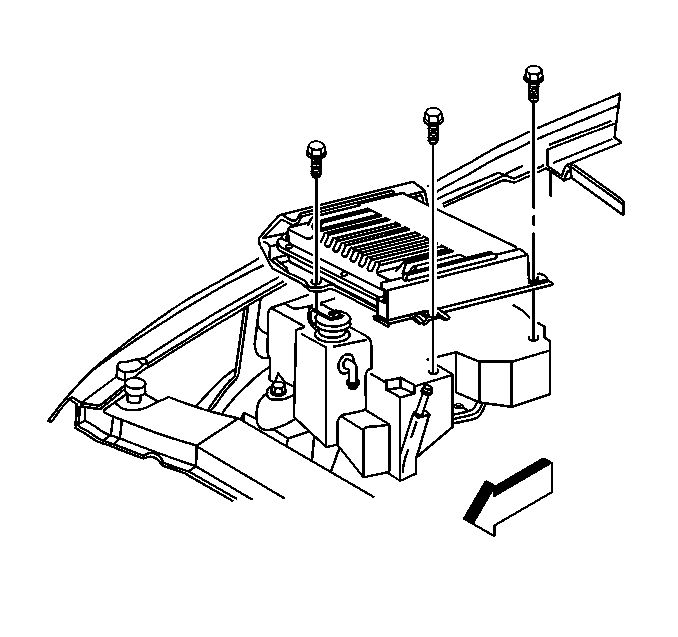
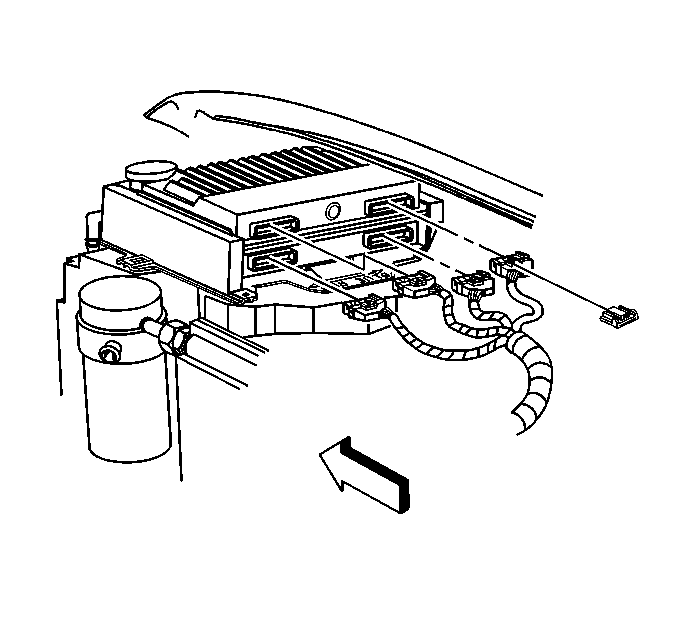
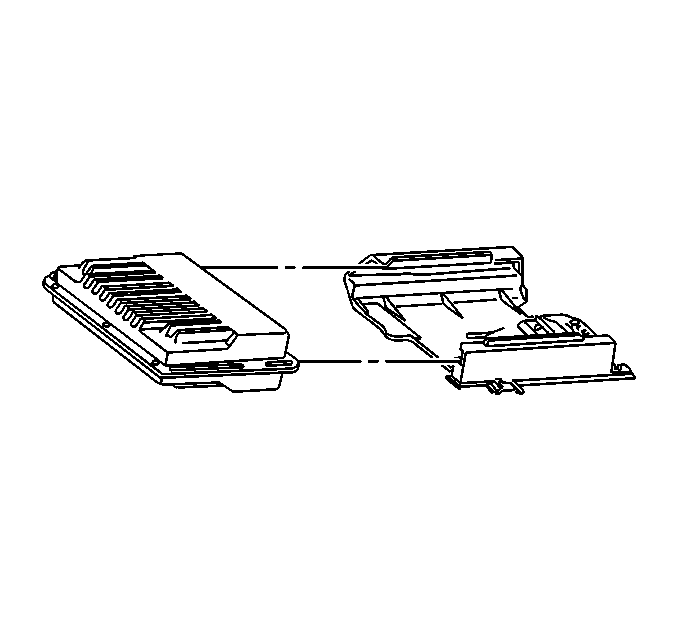
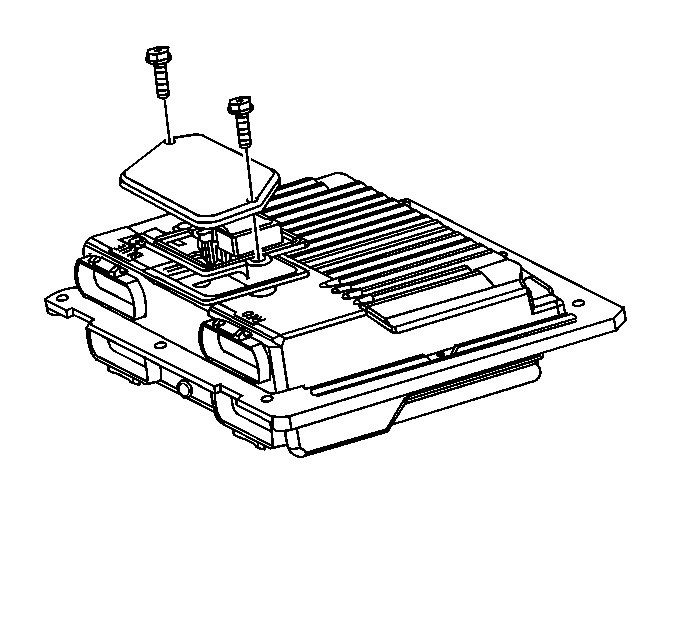
Remove the access cover screws.
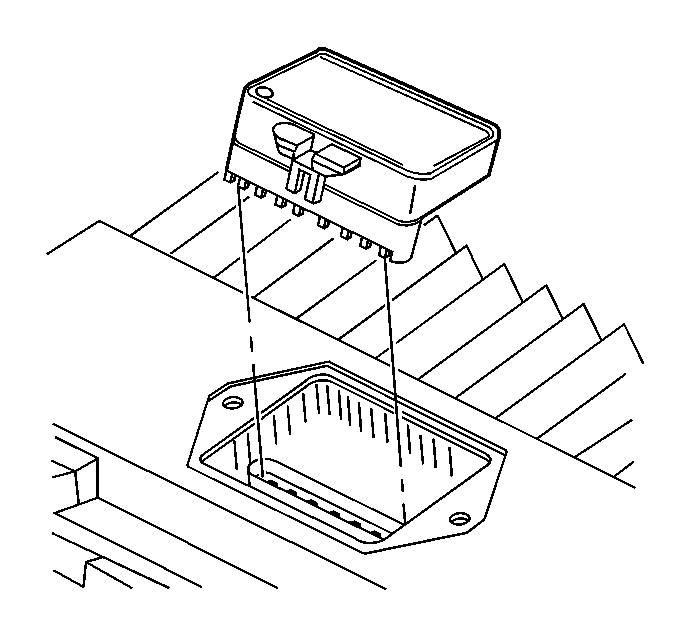
Important: Since the Knock Sensor (KS) module will be used in the replacement VCM, place the module in an area where it will not be damaged.
Installation Procedure
Important: Ensure that the VCM being installed is the original VCM, or that the replacement VCM service number is identical to the original VCM service number.
Steps 1-3 are only necessary for a replacement VCM installation:
- Align the notches of the KS module with the notches in the socket.
- Install the KS module in the KS module socket.
- Install the access cover on the VCM.
- Install the access cover screws.
- Insert the VCM into the VCM bracket until it is fully seated.
- Connect the VCM connectors and retainer clips.
- Insert the VCM bracket at an angle so that the fender side of the bracket is positioned underneath the fender lip.
- Push the VCM bracket underneath the lip until the inside edge of the bracket clears the A/C accumulator.
- Install the VCM bracket bolts.
- Connect the negative battery cable.
- When installing a replacement VCM, perform the VCM Programming procedure.

Notice: In order to prevent possible electrostatic discharge (ESD) damage to the VCM, do not touch the connector pins or soldered components on the circuit board.
Important: Press only on the ends of the KS module. Gently press on the KS module until it is firmly seated in the socket. Listen for the click.

Notice: Use the correct fastener in the correct location. Replacement fasteners must be the correct part number for that application. Fasteners requiring replacement or fasteners requiring the use of thread locking compound or sealant are identified in the service procedure. Do not use paints, lubricants, or corrosion inhibitors on fasteners or fastener joint surfaces unless specified. These coatings affect fastener torque and joint clamping force and may damage the fastener. Use the correct tightening sequence and specifications when installing fasteners in order to avoid damage to parts and systems.
Tighten
Tighten the access cover screws to 5.0 N·m (44 lb in).

Important: Make sure that the snap retainer is up in the normal position and retaining the module.


Notice: Use the correct fastener in the correct location. Replacement fasteners must be the correct part number for that application. Fasteners requiring replacement or fasteners requiring the use of thread locking compound or sealant are identified in the service procedure. Do not use paints, lubricants, or corrosion inhibitors on fasteners or fastener joint surfaces unless specified. These coatings affect fastener torque and joint clamping force and may damage the fastener. Use the correct tightening sequence and specifications when installing fasteners in order to avoid damage to parts and systems.
Tighten
Tighten the bolts to 10 N·m (89 lb in).
VCM Programming
- Perform the following steps in order to prepare for programming the VCM (EEPROM).
- Refer to the Techline terminal and follow the user's instructions for VCM programming.
- If the VCM fails to program, perform the following functions:
- Perform the VTD Password Learn Procedure. Refer to Password Learn .
- Perform the CKP System Variation Learn Procedure. Refer to Crankshaft Position System Variation Learn .
- For a functional check, perform the Powertrain On-Board Diagnostic (OBD) System Check.
| • | Make sure that both the Tech 2 and the Techline terminal software are updated to the most current level. |
| • | Verify that the vehicle battery is properly charged prior to performing the reprogramming process. |
| • | Make sure the connection at the Data Link Connector (DLC) is secure. |
| • | Turn ON the ignition. |
| • | Turn OFF all the accessories (i.e., radio, HVAC controls, interior lamps, etc.). |
| • | Check all the VCM connections. |
| • | Try again to program the VCM. If the programming fails again, replace the VCM. |
